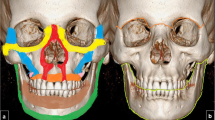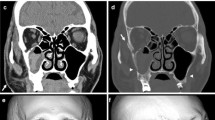Abstract
Our goal was to test the predictive value of high-attenuation material within the maxillary sinus for adjacent facial bone fracture. After IRB approval, all blunt trauma facial CTs performed over a 5-month period at a level II trauma center were reviewed in consensus by three radiologists for the presence of facial fractures or high attenuation maxillary sinus opacity (≥30HU, ≥40HU, or ≥50HU). Three classes of fractures were analyzed: any fracture, any fracture contiguous with the maxillary sinus, and only fractures not contiguous with the maxillary sinus. Statistics were calculated using two-by-two tables. A total of 844 cases were reviewed with 273 patients having any fracture. There were 402 hemi-faces with any fracture and 62 hemi-faces with fracture contiguous with the maxillary sinus. Sensitivity, specificity, positive predictive value, and negative predictive value for any fracture (using the ≥40HU threshold) were 13, 99, 85, and 78 % respectively; for fracture contiguous with the sinus, these were 71, 99, 72, and 99 % respectively; and for only non-contiguous fractures, these were 2.3, 96, 13, and 80 %, respectively. We conclude that in this level II trauma population, lack of high attenuation maxillary sinus material nearly ruled out fractures in contiguity with the sinus. High-attenuation sinus material is only moderately predictive of a fracture contiguous with the maxillary sinus. Therefore, if after careful review a fracture is not identified, the radiologist should not be overly concerned that a fracture is being missed. High-attenuation sinus material is a poor marker for fractures not contiguous with the maxillary sinus.



Similar content being viewed by others
References
Levine CD, Patel UJ, Silverman PM, Wachsberg RH (1996) Low attenuation of acute traumatic hemoperitoneum on CT scans. AJR Am J Roentgenol 166(5):1089–93
Federle MP, Jeffrey RB Jr (1983) Hemoperitoneum studied by computed tomography. Radiology 148(1):187–92
Allareddy V, Allareddy V, Nalliah RP (2011) Epidemiology of facial fracture injuries. J Oral Maxillofac Surg 69(10):2613–8
Peltola EM, Koivikko MP, Koskinen SK (2014) The spectrum of facial fractures in motor vehicle accidents: an MDCT study of 374 patients. Emerg Radiol 21(2):165–71
Salonen EM, Koivikko MP, Koskinen SK (2008) Acute facial trauma in falling accidents: MDCT analysis of 500 patients. Emerg Radiol 15(4):241–7
Tanrikulu R, Erol B (2001) Comparison of computed tomography with conventional radiography for midfacial fractures. Dentomaxillofac Radiol 30(3):141–6
Hammerschlag SB, Hughes S, O’Reilly GV, Naheedy MH, Rumbaugh CL (1982) Blow-out fractures of the orbit: a comparison of computed tomography and conventional radiography with anatomical correlation. Radiology 143(2):487–92
Reddy RP, Bodanapally UK, Shanmuganathan K, Van der Byl G, Dreizin D, Katzman L, Shin RK (2015) Traumatic optic neuropathy: facial CT findings affecting visual acuity. Emerg Radiol 22(4):351–6
Avery LL, Susarla SM, Novelline RA (2011) Multidetector and three-dimensional CT evaluation of the patient with maxillofacial injury. Radiol Clin North Am 49(1):183–203
Lambert DM, Mirvis SE, Shanmuganathan K, Tilghman DL (1997) Computed tomography exclusion of osseous paranasal sinus injury in blunt trauma patients: the “clear sinus” sign. J Oral Maxillofac Surg 55(11):1207–10
Hwang K, Choi HG (2009) Bleeding from posterior superior alveolar artery in Le Fort I fracture. J Craniofac Surg 20(5):1610–2
Yang WG, Tsai TR, Hung CC, Tung TC (2001) Life-threatening bleeding in a facial fracture. Ann Plast Surg 46(2):159–62
Lewandowski RJ, Rhodes CA, McCarroll K, Hefner L (2004) Role of routine nonenhanced head computed tomography scan in excluding orbital, maxillary, or zygomatic fractures secondary to blunt head trauma. Emerg Radiol 10(4):173–5
Conflict of interest
The authors declare that they have no conflict of interest.
Author information
Authors and Affiliations
Corresponding author
Rights and permissions
About this article
Cite this article
Friedman, A., Burns, J. & Scheinfeld, M.H. Significance of post-traumatic maxillary sinus fluid, or lack of fluid, in a level II trauma population. Emerg Radiol 22, 661–666 (2015). https://doi.org/10.1007/s10140-015-1343-4
Received:
Accepted:
Published:
Issue Date:
DOI: https://doi.org/10.1007/s10140-015-1343-4




